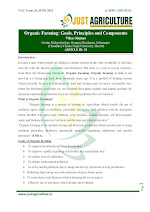Sexual Reproduction in Fungi
Fungi reproduce both asexually (without a nuclear change) and sexually (with a nuclear change). The reproductive bodies are called as spores which are capable of growing into a new thallus.
The
reproductive phases starts when the vegetative phase (Somatic phase) has
reached certain degree of maturity so as to provide sufficient quantities of
reserve food for the spore producing organs.
Sexual reproduction:- This process involves the union of male and female nuclei or nuclei of opposite sex potential. The sex organs are called as gametangia and sex cells are known as gametes. The sexual spores are produced mostly at the end of life cycle of the fungi and sometimes in the middle also. Sexual spores function as resting spore in many fungi but in some fungi they do not have any resting period.
The process of sexual reproduction involves three phases:-
1. Plasmogamy:- Union of two protoplast bringing the haploid nuclei of two opposite sex potential close together within the same cell, ie dikaryon.
2. Karyogamy:- It is the fusion of two nuclei which are compatible or of opposite sexes. The fused cells are called as zygote. It may occur immediately after plasmogamy such as in lower fungi. It leads to the formation of diploid nucleus.
3.
Meiosis:- It is the
third phase in which the fertilized egg (zygote) undergoes the meiotic
division. Meiosis reduces the number of chromosome to haploid (n). The nuclei
get surrounded by a small amount of the cytoplasm and secrete a wall to become
a spore.
Sexual
spores are variously known as oospore, zygospore, ascospore and basidiospore
which are produced respectively by mastigomyctina, zygomycotina, ascomycotina
and basidiomycotina.
Methods of Sexual Reproduction
The
various methods by means of which compatible nuclei are brought together in the
process of plasmogamy are discussed here under.
1. Planogametic Copulation or Conjugation:- A planogamate is a motile gamete or sex cell. The fusion of two gametes, one or both of which are motile is called planogametic copulation. This type of sexual reproduction is common in aquatic fungi. There are three different types of planogametic copulation:-
a.
Copulation of Isogamous Motile Gametes:- In this type
morphologically similar but compatible type of mating type of gametes unite to
form a motile zygote. e.g. Synchytrium.
b.
Copulation in Anisogamous Motile Gametes:- It involves
union of one larger gamete with another smaller gamete. The resultant zygote is
motile.
c.
Heterogamous Planogametic Copulation:- In this type, a
non-motile female gamete (oosphere) is fertilized by a motile male gamete. This
results in the formation of oospores, a resistant structure and resting spore.
2.
Gametangial Contact:- In this method the male gamete
(antheridium) and the female gamete (oogonium) come in contact and one or more
nuclei from the male gamete enter the female gamete, oogonium dissolved in the
intervening wall through a pore or through a fertilization tube. In no case the
gametangia actually fuse or lose their identify during the sexual act. e.g.
Fungi in Peronosporales.
3. Gametangial Copulation:- This is a process of fusion of entire contents of the two mating gametangia. There are two types:-
a). Mixing of Entire Protoplasm of Male and Female Gametangia:- Two gametangia meet and their entire contents fuse in the female gametangium leading to formation of a zygote. e.g. Aquatic fungi (Chytridiomycetes).
b).
Isogamous Copulation:- Two morphologically similar
gametangial hyphae come in contact, the wall at the point of contact dissolves
and the contents mix in the cell thus formed. e.g. Mucor, Rhizopus, Phycomyces.
4.
Spermatization:- Some fungi like rusts bear numerous
minute, non-motile uninucleate, male cells called spermatia. Spermatia are
produced in spiral receptacles called spermagonia. Insects, wind or water to
the female gametangium carries them, which is usually a special receptive hypha
(or trichogyne) to which they become attached. A pore develops at the point of
contact and the contents of spermatium pass into the particular respective
hyphae.
5.
Somatogamy:- In somatogamy to sex organs are
produced and somatic cells function as gametes somatogamy hyphae anastomose and
the nuclei of opposite matting type are brought together in one cell.
Somatogamy is common in Ascomycotina and Basidiomycotina fungi.
Thank You
Vikas Kashyap:)
Contact US










1 Comments
Good appreciable work
ReplyDelete